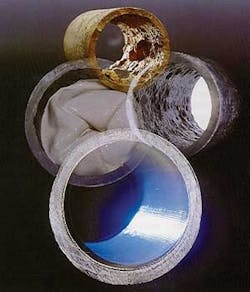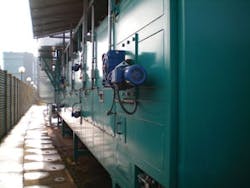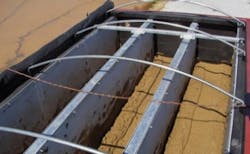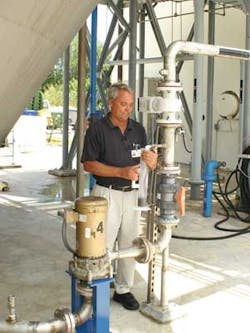New Procedures in Piping Rehabilitation
By Holger Turloff
• First field experiment in Europe of a quick curing procedure for woven fabric relines a DN 500 GG wastewater pressure main in Berlin-Lichtenberg, Rummelsburg district, in the area of Fischerstrasse between KGA Sanssouci and Lückstrasse.
A new DN 500 GG wastewater pressure main was to be rehabilitated for the present building project in Berlin-Lichtenberg, commissioned by Berliner Wasserbetriebe. Due to the city centre location, a trenchless alternative was chosen. Whilst maintaining the supply cross-section of the old pipe, the woven fabric hose variant in starline®HPLS® (High Pressure Liner - Sewer) procedure was selected in combination with starline®EXPRESS curing technology employing ultraviolet (UV) irradiation from Karl Weiss Group.
This new curing method opens up new perspectives for trenchless rehabilitation of collection and distribution systems. Pressure pipelines for all means, in large individual lengths of up to 600m and at operating pressures of up to 30 bar, can be rehabilitated and ready to use in just one working day. As attested by DGVW – the German Technical & Scientific Association for Gas & Water, the life span of this process is greater than 50 years. Due to the very minor civil engineering services, 90% of CO² emissions otherwise accumulating also are avoided.
The following are the fundamental procedural steps of this combination process:
- High-pressure water cleaning up to 1, 500 bar
- Sandblast cleaning
- TV Inspection and pipe calibration
- Woven fabric hose rehabilitation in starline HPL-S procedure
- Curing in starlineEXPRESS procedure.
The pipeline to be rehabilitated was to be worked on and rehabilitated in two segments (95m and 264m). In the preliminary stages, the construction trenches for cleaning and the woven fabric hose fitting were situated alongside the wastewater pressure main and the pipeline detached and emptied.
An initial TV inspection including video recording of the whole pipeline is carried out to obtain an initial overview of the condition of the pipeline and also to pinpoint any possible obstacles preventing cleaning and rehabilitation. During the subsequent cleaning, by means of high-pressure water, all residues such as fats, faeces, incrustations, etc., will be are removed at pressures of up to 1,500 bar.
In the process, the cleaning water that accumulates flows into the local sewer system after sampling. Accumulated sediments are competently removed and disposed of. Subsequent sandblast cleaning guarantees the inner surface of the pipe is metallically pure and, consequently, there's an optimal basis for adherence later on with the woven fabric hose yet to be constructed.
The results of the individual cleaning procedures are assessed and recorded on TV inspections.
Before construction of the woven fabric hose, the whole pipeline is surveyed by means of a self-propelled optical pipe calibration system from the inside in order to determine the exact inside diameter of the pipe at all points of the pipeline. As a result, it's guaranteed that the appropriate and therefore correctly dimensioned woven fabric hose is used.
The subsequent rehabilitation of the woven fabric hose with the starlineHPL-S procedure is subdivided into several work processes. The hose is soaked with dual component adhesive and the adhesive will be evenly spread over the whole length of the hose. For this purpose, whilst the soaked hose is being rolled up on the pressure drum it will be simultaneously pulled through a specific nip. After that, one end of the woven fabric hose is attached to the reverse head and the "filled" pressure drum is placed in to the starting pit. By means of air pressure and an inlet funnel that's mounted on to the pipeline, the woven fabric hose is then installed into the pipeline segment that's to be rehabilitated at a specific reversion pressure and specific speed into the pipeline segment.
The advanced curing procedure is applied to promote accelerated curing of the adhesive soaked woven fabric hose. For this purpose, special hose locks are mounted at the destination point of the rehabilitation section. The woven fabric hose, under internal pressure, is temporarily closed and the end of the hose attached in such a way that the pressure drum can be disconnected and transported to another rehabilitation segment for further rehabilitation. The UV irradiation source is placed into the rehabilitation section through the hose locks over the retention belt.
In doing so, the quality of the built-in reversed woven fabric hose will still be examined with simultaneous camera observation prior to curing in the pipe. Upon curing (see Figure 7), the irradiation source will be put into service and drawn through the pipeline segment at a specific speed. Immediately after irradiation curing through the curing procedure (about three hours are needed for 265m of DN 500) the locks will be dismantled and the rehabilitated pipeline section can be subjected to a pressure test.
After the successful pressure test, the cleaned branches is opened trenchlessly by a grinding robot and the TV approval inspection will be carried out.
The pipeline segments is then attached to the available pipeline network and put into service and the construction trenches will be closed.
Author's Note: Holger Turloff is a qualified engineer with Karl Weiss Technologie-unternehmen GmbH & Co. KG, of Berlin, Germany. Contact: +49 (0) 30 - 80 97 00 - 0, [email protected] or www.karl-weiss-technologies.comMore Water & WasteWater International Issue Articles
More Water & WasteWater International Archived Issue Articles






